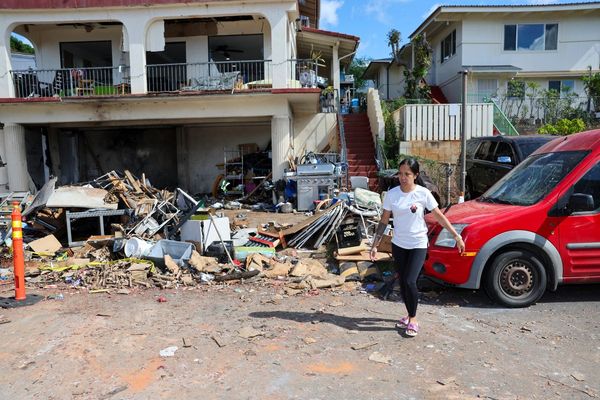
Last year a team of Harvard scientists had an idea involving a large balloon and a small amount of chalk dust. They devised an experiment in which a weather balloon would release less than 2 kilograms of calcium carbonate about 12 miles above a Swedish Space Corporation facility near the arctic town of Kiruna, or possibly a tiny quantity of sulfate particles, equivalent to the amount released in a single minute by a typical commercial aircraft.
These plans were greeted with utter panic. Activist groups declared the "risks of catastrophic consequences" were too great, and there were "no acceptable reasons" for allowing the project to go forward. Experimenting with this technology, they claimed, has "the potential for extreme consequences, and stands out as dangerous, unpredictable, and unmanageable." The Swedish government canceled the tests.
What could possibly be so terrifying about this seemingly innocuous research proposal?
The project was the first step in researching a promising strategy to counteract some of the effects of climate change: stratospheric geoengineering, specifically solar aerosol injection. By dispersing bright particles into the stratosphere where they would reflect sunlight back out into space, the theory goes, humanity might be able to generate a kind of global sunscreen and cool the warming earth. The Harvard researchers hoped to gather some data on aerosol density, particles' effects on atmospheric chemistry, and how well they scatter light to allow climate modelers to improve the fidelity of their simulations.
A decade earlier, British researchers tried to get a similar proposal off the ground. That one involved a kilometer-long hose that would have sprayed two bathtubs' worth of water from a balloon over a disused military airstrip in the Norfolk countryside, allowing scientists to monitor how the wind affected the motion of the balloon and hose.
That, too, was canceled after Friends of the Earth, the ETC Group, and other activists similarly denounced it as a step down a "very high-risk technological path" that "could have devastating consequences" for the world.
Neither of these experiments would have affected the weather, much less the climate, in any way. Yet opposition to stratospheric aerosol injection research, and solar geoengineering research more generally, is intense. The underlying worry isn't that the technology will be a flop. In fact, the most vigorous opponents seem convinced that research into stratospheric geoengineering will show tremendous promise to combat warming quickly and cheaply. And that, they fear, could be the most dangerous finding of all.
An Artificial Pinatubo
This idea of a planetary sunshade isn't new. Researchers have focused on the concept since the 1991 eruption of Mount Pinatubo, a volcano in the Philippines. The eruption explosively injected about 20 million tons of sulfur dioxide into the stratosphere, going more than 12 miles high. Those particles reflected enough sunlight to lower the average temperature of the globe by 0.5 degrees Celsius in 1992.
The earth's average temperature has increased by about 1.1 degrees Celsius since the 19th century due to man-made climate change. Under the 2015 Paris Agreement, the nations of the world committed to keep that increase from going 2 degrees Celsius above the pre-industrial global average. To meet the Paris Agreement's goal, the countries involved made plans to transition away from fossil fuels to no-carbon and low-carbon energy sources, such as solar, nuclear, and wind power. Given plausible energy use and deployment scenarios, recent work by climate researcher Roger Pielke Jr. and his colleagues at the University of Colorado projects the average global temperature to rise by the year 2100 to between 2–3 degrees Celsius, with a median of 2.2 degrees. Pielke notes that this is "within spitting distance" of the Paris goal.
But what if those projections are wrong and the planet warms much faster than calculated? Proponents of solar geoengineering think we might be able to bridge the gap by mimicking the Pinatubo eruption. The most plausible proposal is the one those Harvard researchers want to explore: solar aerosol injection. This would involve annually scattering millions of tons of particles—generally sulfur dioxide, sulfuric acid, or calcium carbonate—into the stratosphere. At this stage they are proposing only to do preliminary work to assess the idea's feasibility.
Where some researchers see promise, others see a possible apocalypse. In January, a group of climate researchers published an open letter in the journal WIREs Climate Change calling for "an international non-use agreement" to prohibit research and development of solar geoengineering technologies. "These proliferating calls for solar geoengineering research and development are cause for alarm," they argued, "as they risk the normalization of these technologies as a future policy option." To stop that, "a strong political message to block these technologies is needed." They seek to completely halt all research in its tracks.
The researchers raise four main objections to researching solar radiation management technologies: They say that it is ungovernable, that it runs the risk of termination shock if the technology is abruptly stopped, that it puts the world on a slippery slope, and that it constitutes a moral hazard.
Ungovernable Research
The authors of the WIREs manifesto claim that solar geoengineering is "impossible to govern fairly and effectively," by which they mean that there is no way for the world to collectively reach a general international agreement on how to implement a solar radiation management program. Since they believe that deployment is ungovernable, then research must be banned.
Is there anything ungovernable about the research itself? The National Academy of Sciences' recent Reflecting Sunlight report offers some recommendations for keeping solar geoengineering under control. For example, funders would "require independent peer review of the research and an assessment of the plausible impacts." Peer review would include public and stakeholder engagement in the design and review of the research. The Harvard project is being guided by just such an outside independent advisory committee.
The report further recommended that funders promote international cooperation, citing the Developing Country Impacts Modelling Analysis for Solar Radiation Management (DECIMALS) project as an example of how to engage solar geoengineering researchers in developing countries. DECIMALS funds research teams in developing countries as they model how solar radiation management could affect their regions. Such teams are currently active in Bangladesh, South Africa, Argentina, and the Philippines, among other places.
Ultimately, the WIREs manifesto fails to make the case that solar geoengineering research is any more dangerously ungovernable than the preliminary research that led to such developments as genetically modified crops, space satellites, and Antarctic exploration.
One oft-expressed concern is that, since climate change is an issue that crosses global boundaries, so too would be the deployment of a stratospheric sunscreen. One country, or maybe even one wealthy individual, could unilaterally deploy a sunscreen affecting the entire world's climate. Noting that the costs of solar geoengineering are relatively low, the political scientist David G. Victor has outlined a scenario in the Oxford Review of Economic Policy in which a single wealthy "self-appointed protector of the planet" decides to deploy solar radiation management on his own.
Dubbed "Greenfinger," after the James Bond villain Goldfinger, this scenario formed the central plot of Neal Stephenson's 2021 cli-fi novel Termination Shock. The Texas plutocrat T.R. Schmidt builds the biggest gun on the planet, dubbed Pina2bo, at his remote ranch, aiming to lower the earth's temperature by firing sulfur-filled shells into the stratosphere. In real life, a coalition of climate activists decried Microsoft founder Bill Gates as "the Sugar Daddy of Geoengineering" in 2020 because he has donated to a fund that has supported the Harvard research project.
Setting lone billionaires aside, the WIREs manifesto worries that "a few countries could engage in solar geoengineering unilaterally or in small coalitions even when other countries oppose such deployment." Kim Stanley Robinson sketches exactly that scenario in his tediously didactic 2020 novel, The Ministry for the Future: In response to a heat wave that kills 20 million citizens, India launches a fleet of aircraft to spray sulfur dioxide in the stratosphere.
Unilateral solar geoengineering is probably legal. As Daniel Bodansky, a law professor at Arizona State University, recently noted in an article for Harvard's Belfer Center, there is no "rule of international law that limits its deployment." It is also unlikely to remain secret: Given that private surveillance satellites have a resolution of around 10 inches, it would be impossible to hide the base for a fleet of sulfur-spraying aircraft or a facility housing other methods of injecting sulfur into the stratosphere. Other countries fearing the possible side effects of solar radiation management might decide to intervene to stop the unilateral deployment, either through economic sanctions or military strikes. In Termination Shock, India—misled by faulty climate modeling—surreptitiously tries to sabotage Schmidt's Pina2bo project, but fails to do so. In fact, a recent study found that solar radiation management would likely moderate the increase in flooding in India that is projected for unabated climate change.
More worryingly, what happens if those countries succeed in stopping such a project after it has already begun?
Termination Shock
Opponents of solar geoengineering research often cite the risk of termination shock as a reason to ban it. If solar radiation management masks a high level of warming, and that management is suddenly halted, they fear this would result in a very rapid increase in temperature—the scenario explored in Stephenson's novel of the same name. An abrupt and complete halt to a longstanding program of solar aerosol injection, suggests some research, could result in a rate of warming that is 10 times faster than if geoengineering had not been deployed. Such a sudden increase in temperatures would obviously have serious consequences for both the natural world and agricultural production that would not have adapted to the new higher temperatures.
But termination shock may be both much less likely and much less risky than previous analyses have suggested. For one thing, there would be a buffer period of months at least before any global temperature rise would become significant.
How might we end up in a termination shock scenario? Researchers Peter Irvine and Andy Parker looked at three ways termination shock could hit and what could be done about them in a 2018 analysis in the journal Earth's Future.
The first pathway is an attack against the deployment infrastructure. This, they note, would be a difficult task: Solar radiation management delivery equipment would be geographically distributed and defended much like nuclear power plants and military bases are now. In addition, countries deploying solar radiation management would likely have or could quickly assemble backup equipment that would maintain solar radiation management cooling before temperatures start to rise rapidly.
The second pathway would be a global economic cataclysm. Given how relatively cheap solar radiation management is likely to be, Parker and Irvine calculate that the global gross domestic product would have to drop by 90 percent before maintaining solar radiation management would cost more than 1 percent of the world's post-catastrophe economy. For comparison, the devastation of World War II reduced European GDP by 21 percent.
Their third pathway would be for some countries simply to choose to cease solar radiation management. In such a case, other countries could ramp up their solar radiation management efforts. Considering the climate effects of a swift end to solar radiation management, parties wanting to end solar radiation management would likely be open to a gradual phase-out of deployment.
Slippery Slopes and Moral Hazards
In a 2019 statement, the Climate Action Network-International (a coalition of 1,500 activist groups from 130 countries) claimed that solar radiation experiments could end up "dragging the world to a 'slippery slope' where larger experiments will be required to validate previous ones that may have failed or not deployed at sufficient scale. Unforeseen consequences of human intervention into the climate and weather systems are to be expected." The authors of the WIREs manifesto similarly warned that these experiments could lead to "'locking in' solar geoengineering as an infrastructure and policy option."
That is not how scientific research usually proceeds. Most research on new technologies is a dead end, as the then-UCLA legal scholar Jesse L. Reynolds pointed out in a 2020 article in WIREs Climate Change. For example, only 10 percent of clinical trials result in a pharmaceutical treatment. What's more, even successfully developed technologies have been abandoned—supersonic passenger airplanes, for example. Claims that researching solar aerosol injection is the beginning of a slippery slope toward deployment is largely alarmist hand waving.
A stronger argument, and the most prevalent one, is that a cheap effective strategy for stopping or even reversing warming could create a moral hazard. In the insurance industry, moral hazard occurs when insured parties take greater risks because they know their insurers will protect them against losses. In the context of geoengineering, a 2014 article in Philosophical Transactions of the Royal Society A observes that "the moral hazard is not so much an economic risk but a social, ethical and political one. Geoengineering might be perceived as an insurance policy against climate change, undermining support for existing climate policies."
In the words of the WIREs manifesto, "Speculative hopes about the future availability of solar geoengineering technologies could threaten commitments to mitigation and reduce incentives for governments, businesses, and societies to do their utmost to achieve decarbonization or carbon neutrality as soon as possible." They are particularly worried that fossil fuel interests will duplicitously campaign to adopt geoengineering rather than switching to non-fossil fuel energy sources. Solar radiation management would function as an emergency cooling system for the planet, but it is not a permanent solution to climate change caused by loading up the atmosphere with extra greenhouse gases, chiefly carbon dioxide from burning fossil fuels.
In the case that man-made warming turns out to be much faster than currently projected, putting up a stratospheric sunscreen would provide humanity extra time in which to develop and deploy low-carbon energy technologies and devise ways to reduce the extra carbon dioxide in the atmosphere. An additional issue is that even as temperatures are moderated by solar radiation management, increasing levels of carbon dioxide will continue the process of ocean acidification, which may have detrimental effects on the functioning of marine ecosystems.
But critics of solar geoengineering focus almost entirely on the possibility that it might discourage efforts to cut greenhouse gas emissions while ignoring its possible reductions in climate change's deleterious effects. "Climate change poses severe risks to ecosystems and humans, especially to the already vulnerable," Reynolds points out. "If solar radiation management could reduce these risks, as current evidence indicates, then an ethical duty to at least explore its potential seems reasonable." He dryly observes that focusing solely on the possible downsides of solar radiation management is "analogous to considering only that seat belts cause car drivers to drive faster while neglecting the belts' safety effects."
Tools for Future Generations
All of this fevered opposition contrasts strongly with the findings in the National Academy of Sciences' Reflecting Sunlight report, which concluded that doing some preliminary research on how to dim the sun is a good idea. The committee suggested a "reasonable initial investment" in solar geoengineering research would be "in the range of $100–200 million total over 5 years." Similarly, the Intergovernmental Panel on Climate Change's most recent assessment, released last year, assigned "high confidence" to the finding that solar radiation modification could offset greenhouse gases' climate effects.
In a 2021 article for Climatic Change, Yale geoengineering lecturer Wake Smith and White House energy expert Claire Henly acknowledge the concerns that research on solar radiation management might constitute a moral hazard. But that doesn't mean, they add, that "the right response is to limit [solar aerosol injection] research in a bid to shroud the future in ignorance and foreclose to it certain options."
We are bequeathing to our descendants a world in which the climate is changing in what may be very deleterious ways. "In this context," Smith and Henly ask, "is it justified for us to deprive future generations of tools that may lessen the pain we have inflicted? They may or may not use these tools, but surely those decisions are theirs to make."
The post The Fight To Stop Research Into a Cheap, Effective Backup Plan for Climate Change appeared first on Reason.com.







